In the world of modern electronics, where technology continues to evolve rapidly, membrane switches play an integral role. These unassuming components are pivotal in offering seamless functionality and user-friendly interfaces in a myriad of devices we use daily. Let’s delve into what membrane switches are and why they are crucial in today’s technological landscape.

What Are Membrane Switches?
Membrane switches are the unsung heroes behind many of our everyday electronic interactions, providing a cost-effective and highly adaptable method for users to engage with a wide array of devices. These switches serve as a crucial interface, allowing the user to communicate commands to the device in a seamless and efficient manner. At their core, membrane switches are composed of several flexible layers, typically involving materials like polyester or polycarbonate, which are not only resilient but also versatile enough to be tailored to specific applications. This adaptability is one reason why they are found in such a vast array of devices, from simple remote controls to complex medical equipment source.
One key aspect that distinguishes membrane switches from traditional mechanical switches is their low profile. This characteristic enables the integration of membrane switches into the sleek and modern designs that consumers have come to expect from their electronic gadgets. This not only enhances the aesthetic appeal of devices but also provides a practical benefit by saving space, which is particularly valuable in compact devices or environments where space is at a premium. Their design typically comprises a graphic overlay, which serves as the interface, a spacer layer, and one or more circuit layers. Each press on the switch results in a contact being made between thin layers of conductive inks within the switch, thus acting as a simple yet effective communication channel with the device.
Key Features and Advantages
A prime advantage of membrane switches lies in their sealed construction, which provides excellent resistance to environmental factors such as moisture, dust, and dirt. This makes them particularly well-suited for use in environments where contamination could otherwise lead to malfunctions source. Furthermore, the materials used in membrane switches are typically chosen for their durability and longevity, ensuring that the switches can withstand considerable use without losing functionality. This durability, coupled with their lightweight design, makes them a popular choice in industries ranging from consumer electronics to transportation, where reliability is paramount.
In terms of user interaction, membrane switches offer distinct advantages in feedback and ease of use. Tactile options typically incorporate domes that provide a physical sensation, often described as a ‘snap’ or ‘click’, when a button is pressed, confirming successful actuation. This type of feedback is essential in applications where precision is critical and serves to enhance the user’s confidence in operating the device. Some designs even incorporate LED backlighting to improve visibility in low-light conditions, further enhancing the interaction experience by providing clear visual cues alongside the tactile feedback. This combination of features ensures that users can trust membrane switches to deliver reliable performance in demanding applications.
Furthermore, from a manufacturing perspective, membrane switches are highly advantageous due to their cost-effectiveness. Their simple construction, comprising a limited number of components, allows them to be produced in large quantities at a relatively low cost. This economic efficiency is matched by their customizability—manufacturers can easily adapt membrane switches to meet specific requirements, making adjustments in size, shape, color, and functionality with minimal difficulty. This flexibility is invaluable across industries with diverse needs, allowing custom solutions to be implemented swiftly without incurring prohibitive costs.
Applications in Modern Devices
Membrane switches are ubiquitous in numerous applications, embedded in devices ranging from the critical to the commonplace. In healthcare, for example, these switches are utilized in equipment where precision and reliability are non-negotiable, such as in patient monitoring systems and diagnostic tools. Their ability to maintain consistent performance under heavy use while remaining easy to clean is particularly valuable in meeting the stringent health and safety standards present in clinical environments source.
In the world of consumer electronics, membrane switches can be found in products such as microwave oven control panels, calculators, and office equipment, including photocopiers and fax machines. This prevalence is largely due to the switches’ flat, unobtrusive design that fits seamlessly into ergonomic layouts. Additionally, the customizable aesthetic appeal offered by these switches allows brands to provide intuitive, easy-to-navigate interfaces that enhance user engagement and satisfaction. For households, this means equipment that is not only more reliable but also easier to use, providing a better user experience overall.
Beyond everyday consumer devices, membrane switches also play a vital role in industrial applications. Control systems in factories and industrial machinery often incorporate these switches due to their ruggedness and ability to withstand exposure to environmental factors such as dust and vibrations. Furthermore, their compact design is beneficial in facilitating the use of membrane switches in spatially constrained areas within machinery, thereby streamlining operations and improving safety without sacrificing ease of use. Additionally, the inherent design flexibility allows them to be easily adapted to match the specific requirements of complex industrial equipment, ensuring optimal functionality in even the most demanding situations.
The Technology Behind Membrane Switches
The core technology of membrane switches is ingeniously simple yet highly effective. They leverage a layered construction where each component plays a vital role, combining to create a responsive and dependable interface source. At the top, the graphic overlay serves as the face of the switch, providing visual and tactile points of contact for the user. Underneath this layer lies a conductive circuit, usually created with printed conductive inks, which transfers the electrical signals generated by each button press.
One feature that sets membrane switches apart from many traditional alternatives is their versatility in circuit design. With advances in printing technologies, manufacturers can now meticulously apply conductive inks to precise positions, allowing the integration of complex circuitry within the slim profile of the switch. This streamlined process not only increases the efficiency of the manufacturing process but also enhances the potential for customization, enabling unique designs tailored to specific applications. The process requires precision, as the alignment of the overlay graphics with the underlying circuits must be exact to ensure proper function and user input accuracy.
Additional components, such as conductive domes for tactile feedback or light-emitting diodes for enhanced visibility, can also be integrated into the switch design. These enhancements expand the range of applications for membrane switches, allowing them to be used in environments where user feedback is crucial or where the device must communicate status or operational modes visually. Incorporating these features requires careful consideration of the switch’s operating context to ensure functionality and reliability remain uncompromised even as more features are added.
Future of Membrane Switches in Electronics
As the landscape of electronic devices continues to evolve, the role of membrane switches is expected to expand. Innovations in materials science and circuit design promise to enhance the capabilities of these versatile components, pushing the boundaries of what is possible with this already highly adaptable technology. For instance, the development of more resilient and flexible materials could lead to switches that boast even greater durability and environmental resistance, making them suitable for more demanding applications source.
Additionally, there is significant potential in harnessing emerging technologies such as Internet of Things (IoT) connectivity and augmented reality (AR) interfaces. By integrating these advancements, membrane switches could become integral components in smart devices, offering intuitive touch-based control that responds dynamically to user interactions. The adaptability of membrane technology is well-suited to these forward-looking applications, providing a scalable solution that can be seamlessly embedded into new and existing electronic systems alike.
In conclusion, membrane switches are far from reaching the limits of their potential. As technology continues to advance, their role is set to grow, offering new functionalities and greater efficiency in electronic interactions. From enhancing user experiences to enabling new capabilities in devices, the future of membrane switches promises exciting developments. To keep pace with these changes, industry leaders are encouraged to explore membrane switch innovations actively, leveraging their benefits to remain competitive and meet the increasing demands of today’s technology-driven world. For those interested in learning more about sophisticated membrane switch solutions, working with a trusted partner like RSP ensures access to cutting-edge expertise and support.
Embracing the Future with Membrane Switches
From their versatility and durability to their cost-effectiveness, membrane switches are undeniably important in modern electronics. As technology continues to advance, their role is set to expand, offering even more possibilities for innovation in device interfaces. Understanding their function and benefits gives us greater appreciation for the devices we rely on every day.










